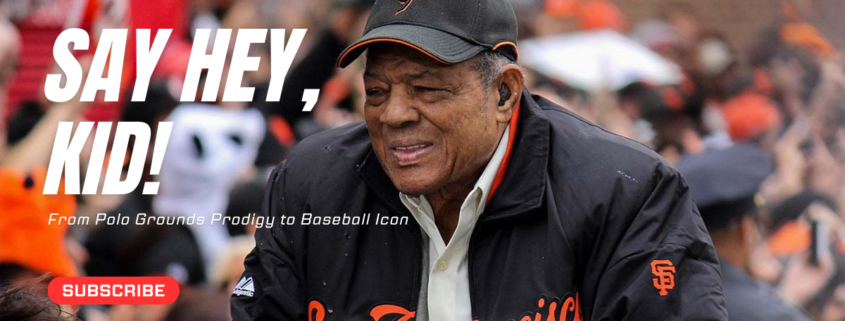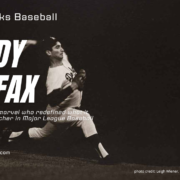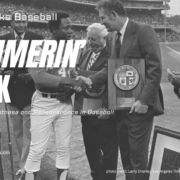Say Hey Kid: From Polo Grounds Prodigy to Baseball Icon (1931-2024)
Electric lights bathed the Polo Grounds in New York City on a crisp 1951 night. A nervous energy crackled in the air, but rookie Willie Mays stood poised in the outfield, a beacon of calm amidst the roar. Nicknamed “The Say Hey Kid” for his infectious joy, Mays wasn’t your average rookie. He was a prodigy, a five-tool threat who’d dominated the Negro Leagues before landing with the New York Giants. Tonight, under the watchful eye of a nation yearning for a hero, Mays would take his first steps on a path towards baseball immortality.
The cheers that washed over Mays that night were a prelude to a future symphony of dazzling catches, tape-measure home runs, and stolen base wizardry. But fate rarely follows a straight line. While Mays would become synonymous with the Giants, his journey wouldn’t be a simple one. For the next two decades (1951-1970), he patrolled center field for both the New York and San Francisco Giants, even leading them to a World Series appearance in 1962. However, a late-career trade in 1972 saw him switch coasts, donning the blue and orange of the New York Mets for a season and a half, primarily playing first base before hanging up his cleats in 1973.
Retirement wasn’t the end for Mays. Baseball was in his blood. He transitioned into coaching, rejoining his beloved Mets (1973-1979) as a hitting coach. His booming voice and infectious enthusiasm became a guiding light for a new generation of sluggers. While championships might not have defined his coaching career, his impact on young players was undeniable.
Mays’ legend and baseball IQ secured him a special place within the San Francisco Giants organization, though he never held an official executive title. Essentially a lifelong ambassador, he bridged the gap between the team’s glorious past and its future. He scouted young talent, mentored players, and served as a constant reminder of the Giants’ winning tradition. His presence, a constant smile radiating the joy he brought to the game, was a testament to his enduring legacy.
Beyond the Stats: A True Giant
Mays’ accomplishments on the field were staggering: a .302 career batting average, over 3,000 hits, a staggering 660 home runs (3rd all-time at his retirement), and a collection of stolen bases, Gold Glove awards, and All-Star appearances that would make any player blush. But his brilliance extended far beyond mere statistics.
His fellow players recognized his greatness. Hall of Famer Hank Aaron called him the “greatest all-around player in baseball history,” while Yankees legend Mickey Mantle lauded his “effortless power and grace in the outfield.” Even opposing managers acknowledged his dominance, with Whitey Herzog stating, “Willie Mays was the only player I ever managed against who could single-handedly beat you in a game.” These are just a few testaments to the awe-inspiring talent that made Willie Mays a true giant of the game.
Mays’ personal life mirrored the twists and turns of his baseball journey. He was married twice, cherishing his family despite a first marriage ending in divorce. Though baseball was his passion, he remained a beloved figure both on and off the field.
More Than Baseball: A Champion for All
Baseball remained Mays’ lifelong passion, but his impact extended far beyond the diamond. A champion for civil rights, he used his platform to advocate for equality throughout his career. He also possessed a genuine warmth and infectious joy that transcended the game. Whether playing stickball with neighborhood kids or charming fans with his signature smile, Mays embodied a spirit of inclusivity and love for the community. This dedication to others solidified his place not just as a baseball legend, but as a true cultural icon.
Mays’ rise to stardom wasn’t without its interruptions. Drafted into the Army during the Korean War era, his promising young career was put on hold for nearly two years (1952-1954). Stationed at Fort Eustis, Virginia, Mays’ military service was unique. Classified as a baseball instructor, he spent most of his time playing for the base team, honing his skills alongside other major and minor leaguers. While he missed valuable playing time with the Giants, this experience arguably helped him refine his game and return with renewed focus, ready to solidify his place among baseball’s greats.
As the final out was recorded and the crowd’s roar faded, Willie Mays tipped his cap, a wide grin splitting his face. The game was won, another chapter etched in his remarkable career. But for Mays, baseball was more than victories and statistics. It was a stage for showcasing brilliance, a bridge between communities, and a wellspring of joy that he tirelessly shared with everyone he met. He wasn’t just a baseball player; he was a symbol of hope, a reminder that with hard work and a smile, anything was possible. And as he walked off the field, the cheers echoing in his ears, Willie Mays knew his legacy wasn’t confined to the diamond. It was woven into the hearts of fans, young and old, a testament to the enduring power of baseball and the man who embodied its spirit – “The Say Hey Kid.”
Hitting
- .302 career batting average
- Over 3,000 career hits
- 660 career home runs (3rd all-time at his retirement)
Defense
- Won a record 12 consecutive Gold Glove Awards in center field
Awards and Recognition
- World Series Champion (1954)
- Two-time National League Most Valuable Player
- 24-time All-Star
Coaching
- Guided a new generation of sluggers as a hitting coach
Thank you for tuning in to forty4 Talks Baseball. Get more at forty4talksbaseball.com
photo credit: Michael Marconi, CC BY 2.0, via Wikimedia Commons










Leave a Reply
Want to join the discussion?Feel free to contribute!